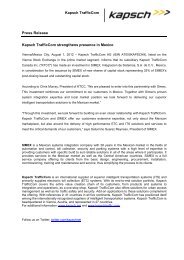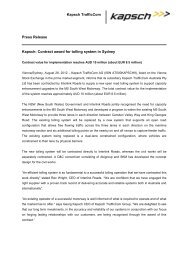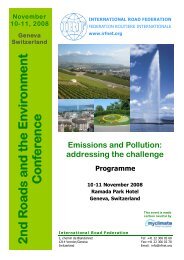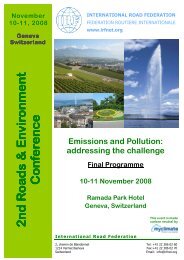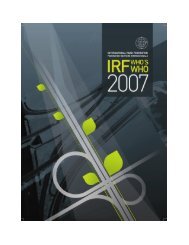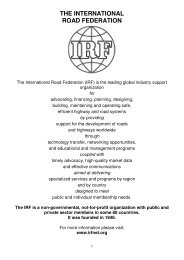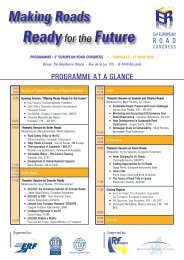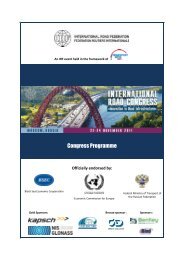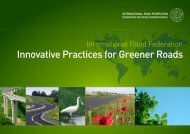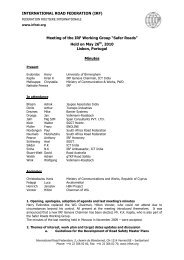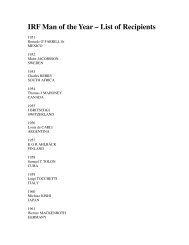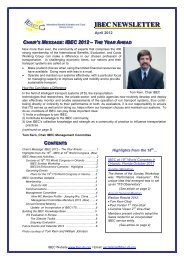Motorways and Urban Mobility - International Road Federation
Motorways and Urban Mobility - International Road Federation
Motorways and Urban Mobility - International Road Federation
Create successful ePaper yourself
Turn your PDF publications into a flip-book with our unique Google optimized e-Paper software.
of only three lanes, instead of the four required when<br />
using barrels. This would give the contractor an extra<br />
lane to exp<strong>and</strong> the work zone, keeping workers safe <strong>and</strong><br />
accelerating construction. 1.7 miles (2.7 km) of moveable<br />
barrier were deployed as a positive separation between<br />
east <strong>and</strong> westbound traffic, <strong>and</strong> the barrier was moved<br />
several times daily to create a 1/2, 2/1 traffic pattern based<br />
on peak traffic needs. The barrier was transferred 12 feet<br />
(3.7 meters), or one lane width, in one pass at 5 mph (8<br />
km/h). The entire transfer took approximately 20 minutes,<br />
including repositioning the traffic control <strong>and</strong> signage.<br />
Thanks to the exp<strong>and</strong>ed work zone, the contractor was<br />
able to use larger, more efficient equipment, <strong>and</strong> work<br />
unimpeded for longer periods of time. This resulted in<br />
the elimination of one complete phase of construction,<br />
effectively reducing the total number of phases from three<br />
to two. The accelerated construction schedule enabled the<br />
contractor to finish the project seven months early. In a<br />
report commissioned by UDOT, <strong>and</strong> compiled by T.Y. Lin<br />
<strong>International</strong>, the user delay savings made possible by the<br />
early completion were estimated at between USD 1.3 to<br />
1.4 million (vehicle operating costs were not included).<br />
The benefits flowing from the use of moveable barrier<br />
also included reduced user costs, shorter travel distances,<br />
improved safety, lower impacts to businesses, reduced fuel<br />
use <strong>and</strong> diminished air pollution. The report conservatively<br />
estimated the total benefits of using moveable barrier<br />
TYPICAL WESTBOUND PEAK<br />
Movable Barrier Traffic Control Options<br />
3500 South Arterial, Salt Lake City, UT.<br />
ROAD CONSTRUCTION<br />
on the project at between USD 1.7 to 2.4 million, with a<br />
benefit/cost ratio of 4:1. The authors also expressly stated<br />
that if the full range of benefits were taken into account<br />
(such as the reduced emissions <strong>and</strong> the benefits accruing<br />
to businesses from early completion), the benefit/cost ratio<br />
would be greater than 10:1.<br />
In addition, the T.Y. Lin report estimated that the barrier<br />
eliminated 20 to 25 left-turn crashes while in operation,<br />
leading to an estimated reduction in crash costs of an<br />
additional USD 1,000,000.<br />
Quickchange® Moveable Barrier (QMB) has been used in<br />
construction work zones in the United States <strong>and</strong> internationally for<br />
more than twenty-five years.<br />
IRF BULLETIN SPECIAL EDITION: URBAN MOBILITY |<br />
08






